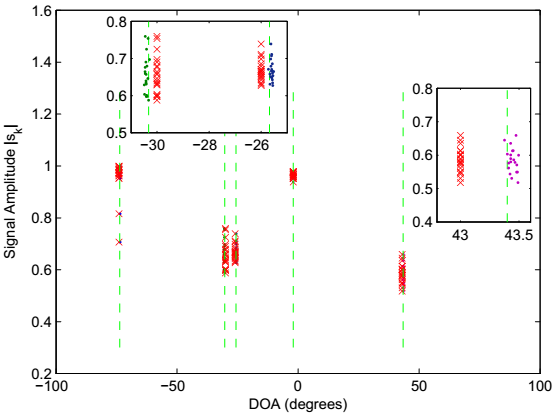Direction of arrival (DOA) estimation is a basic and important problem in signal processing and has been widely applied. Its research has been advanced by the recently developed methods based on Bayesian compressive sensing (BCS). Among these methods, the ones combined with an off-grid (OG) model have been proved to be more accurate than the on-grid ones. However, the conventional BCS-based methods have a disadvantage of the slow speed.
A high-efficiency iterative algorithm is recently developed by researchers from the Institute of Acoustics of the Chinese Academy of Sciences, based on the fast relevance vector machine (FastRVM) and the off-grid model. This new approach applies to both the single- and multiple-snapshot cases. Precisely, the offset factors are adopted to diminish the deviation produced by the unideal DOA position. Combining the FastRVM technique, this algorithm can realize the high-accuracy and efficient DOA estimation.
The performances of both FastRVM and OG-FastRVM algorithms are illustrated in Fig. 1 shown below. 20 experiments have been done by researchers, and the DOAs of five signals in each experiment are [−73.7◦, −30.32◦, −25.68◦, −2◦, 43.4◦]. In this simulation, the signal-to-noise (SNR) ratio is 20dB. The amplitudes and directions of the simulation signals denoted by circle are shown in Fig. 1. It is evident that OG-FastRVM can get a more accurate estimation than FastRVM without the off-grid technique.

Fig. 1. Single sample DOA estimation using FastRVM and OG-FastRVM as the detail illustrations: SNR = 20dB, K = 5, ∆θmin= 4.64◦, 20 trials. Here, '·’ and ’×’ represent OG-FastRVM and FastRVM respectively, and the dashed-line represents the actual position of DOAs (Image by LIN).
The proposed algorithm is based on the fast RVM, and utilises the off-grid technique in each iteration. The results of numerical simulations have illustrated that the proposed approach outperforms the standard ℓ1-penalisation algorithm. Furthermore, OG-FastRVM computes more efficiently than both ℓ1-penalisation and OG-SBI (sparse Bayesian inference).
Moreover, the MT-OG-FastRVM (multiple-snapshot version of OG-FastRVM) has also been realized by the combination of OG-FastRVM and MT-BCS. The DOA estimation performance of this MT method exceeds the single-snapshot (OG-) FastRVM.
Precisely, with the increase of the number of snapshots, the root mean square error decreases. Finally, the MT-OG-FastRVM method is compared with the state-of-the-art ones. Comparisons with state-of-the-art methods and Cramer–Rao bound are also reported. Especially with a small number of snapshots, the proposed method provides more accurate estimates than the other compared methods.
Funding for this research came from the National Natural Science Foundation of China (Grant Nos. 61222107 and 61471352).
Reference:
LIN jincheng, MA Xiaochuan, YAN Shefen, HAO Chengpeng and LIN Geping. Off-Grid Fast Relevance Vector Machine Algorithm for Direction of Arrival Estimation. IET Radar, Sonar & Navigation (12 November 2015). DOI: 10.1049/iet-rsn.2015.0304
Contact:
LIN Jincheng
Institute of Acoustics, Chinese Academy of Sciences, 100190 Beijing, China
Email: ljcmym@163.com


